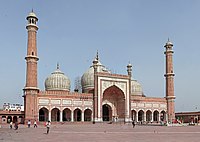
Photo from wikipedia
The Indo‐Asian Monsoon (IAM) has changed as the topographies of Asia were assembled into their current configuration. Understanding complex interactions between topography and the IAM through time has been hampered,… Click to show full abstract
The Indo‐Asian Monsoon (IAM) has changed as the topographies of Asia were assembled into their current configuration. Understanding complex interactions between topography and the IAM through time has been hampered, in part, by poorly resolved topography and atmospheric dynamics in climate models. Here, we employ high‐resolution (0.23° × 0.31°) global climate simulations, to more accurately capture these interactions. We find that the Himalayas and Tibet primarily redirect the onshore moisture transport and produce local orographic precipitation. The Iranian Plateau is the primary gatekeeper, insulating the pool of high‐enthalpy air in the Indo‐Gangetic Plain (IGP) from westerly low‐enthalpy advection. But, even when such high‐enthalpy air exists along the IGP, vigorous precipitation in the region (poleward of 25°N) still requires orographic steering and lifting. The large‐scale circulations—largely governed by sea surface temperature gradients—robustly advect water vapor onshore regardless of topography. Thus, neither topography nor localized enthalpy air drives onshore monsoon flow.
Journal Title: Geophysical Research Letters
Year Published: 2020
Link to full text (if available)
Share on Social Media: Sign Up to like & get
recommendations!